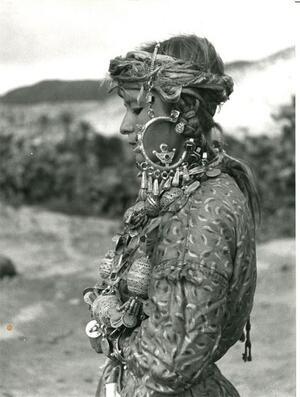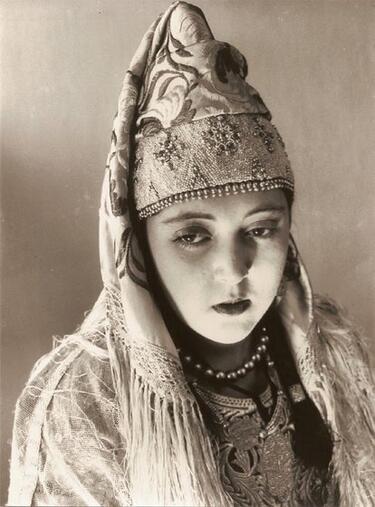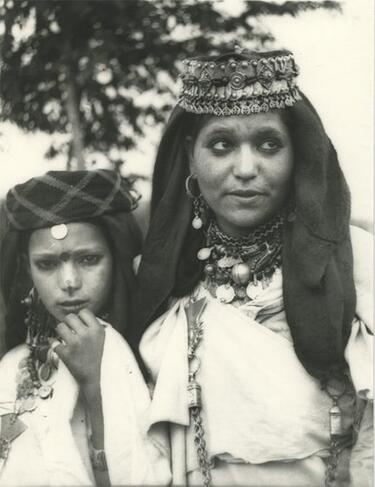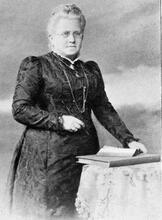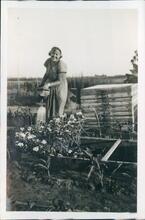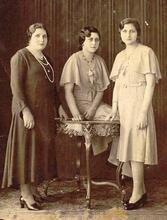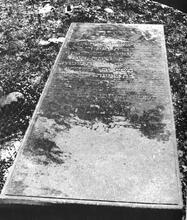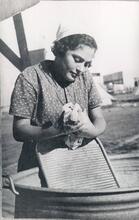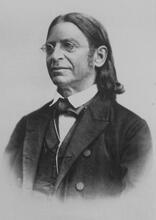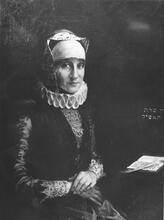Morocco: Nineteenth and Twentieth Centuries
The Moroccan Jewish community was the largest Jewish community in North Africa during the nineteenth and twentieth centuries. The status of Moroccan Jewish women was affected by a variety of factors, including a patriarchal order and social changes brought about by economic development, urbanization, and contact with European countries. Marriage and motherhood were defined by a very strict set of patriarchal gender roles, enforced by traditions such as the ketubah and the laws of niddah. Jewish women’s gender status was influenced greatly by the spread of formal schooling that began in the 1860s, which brought literacy to women in all socio-economic groups. In particular, girls from less affluent Jewish families viewed education as an opportunity for social mobility. The expansion of educational opportunities brought an increase in women’s participation in the work force, and this new role for women in turn influenced spousal relations and gender roles.
The Moroccan Jewish community during the nineteenth and twentieth centuries was the largest Jewish community in North Africa, though it always constituted a small minority among its Muslim neighbors (Tsur, 2001). In the absence of formal statistics, it has been estimated that approximately 120,000 to 130,000 Jews lived in Morocco at the beginning of the nineteenth century. Formal statistics calculated later revealed that 160,000 Jews lived there in 1936 (Hatal, 1964) and 240,000 in 1952 (Laskier, 1983). As a result of emigration to Israel and other countries, the number decreased to 160,000 by 1960 (Laskier), but it nevertheless remained the largest Jewish community in the region.
The female gender roles and status of Moroccan Jewish women during the nineteenth and twentieth centuries were influenced by a patriarchal order, by Jewish religious writings and their interpretations by local rabbis, and by the surrounding Muslim society, which was often hostile to the Jewish communities. Their roles and status were also affected by social changes brought about by economic development and urbanization, induced through contact with European countries, particularly during the colonial period of the French Protectorate that lasted from 1912 to 1956, the year of Moroccan unification and independence.
Marriage and Motherhood
Two of the major components of women’s gender roles were their family roles as wives and mothers, the primacy of which was based on religious writings. It was by fulfilling them that women fortified their status in the community.
Child marriages were common during the nineteenth century. Girls tended to marry between twelve and fourteen years of age, usually with the onset of menses, and boys between fourteen and sixteen. This was true for all classes in Jewish communities. In rural areas some marriages took place between even younger children (Bashan, 2000). During the pre-colonial period, marriages were arranged by family members and, according to religious dictates, took place within the extended family, generally between cousins (Deshen). Since families usually shared business activities, this overlapping of marital and economic ties strengthened family networks and was conducive to the success of the marriage.
Upon her marriage, the bride was given a dowry by her family, usually consisting of jewelry and clothing. Because the dowry was intended for her personal use, it did not have economic value and did not provide her with financial resources of her own. However, it did have symbolic value: its amount reflected the wealth and status of her family (Deshen).
The Ketubbah
If the dowry did not represent wives’ independent financial resources, the ketubbah was intended to do so. The ketubbah was a religious document signed by the groom at the wedding in the presence of two witnesses. According to Bashan, it specified the spouses’ mutual obligations and the money to be paid by the husband or his heirs to the wife in case of divorce or his death. The amounts varied according to the norms of the local rabbinical court, the husband’s financial state, and the marital status of the wife. Previously unmarried women (presumably virgins) were granted larger amounts than widows or divorcées, who were considered the least desirable (Bashan). Thus men (rabbis and husbands) created a hierarchy of status among women by means of the categories that they determined.
According to the ketubbah, husbands were expected to be respectful to their wives, to love and support them, to be non-violent, and to have sexual relations with them. Wives were expected to conform to religious commandments and to be respectful to their husbands, obedient, modest and fertile. A husband’s complaint to the rabbinical courts that his wife had violated these expectations could result in her being divorced and being denied the financial settlement noted in the ketubbah (Bashan). Thus, while the ketubbah was intended to provide some economic support for women in case of divorce or their husband’s death, it can also be understood as a powerful means of social control: it pressured wives to comply with men’s (rabbis’ and husbands’) demands or risk losing their source of financial security.
Once married, the young couple lived with the husband’s father and his other married sons in an extended family living area. By the end of the nineteenth century, this close proximity, natural increase and the migration of Jews from the villages to the cities created extremely crowded living conditions within the Jewish ghetto (mellah) of the major cities. This proximity was often a source of inter-generational conflict and tension between spouses (Deshen).
Norms of Modesty and Niddah
The norm of modesty, which derived from religious sources, was strictly enforced until approximately the end of the nineteenth century and led to the almost total seclusion of married women. Modesty obligated wives to cover their hair and married women in the Atlas Mountains region were expected to cover their faces as well, as was customary among Muslim women. However, the norm of modesty also dictated that wives remain at home, out of public view, segregated from men. Wives were not permitted to leave their homes, even to visit their relatives, without their husband’s consent. While this total seclusion was the norm for all the women in the Jewish community, evidence suggests that it was practiced to lesser degrees by poor women and older women (Shitreet, 2000; Mizrachi, 2003).
Researchers have offered several possible explanations for this seclusion. Some have understood it as the enforcement of the religious demand for the modesty of women (Bashan). Berman (1976) maintained that this seclusion concretely defined the division of labor between genders in which women were expected to deal with domestic duties and husbands with non-domestic activities such as formal religious tasks, economic activities and communal affairs. Still others, such as Azmon (1995), have suggested that this seclusion created and preserved hierarchical power relationships between men and women. By relegating women to domestic duties and considering these as less important than non-domestic duties, men retained their dominant position in Jewish society (Azmon, 1995). Regardless of which explanation is adopted, one can conclude that seclusion led to exclusion and the perpetuation of patriarchy.
The observance of niddah served as a means by which women fulfilled the religious component of their female gender role. Niddah refers to the religious laws relating to separation and reunion between spouses during and after menstruation. Because male contact with menstrual blood, considered impure, was forbidden, couples were not permitted to have sexual relations during the wife’s period and were only allowed to resume these relations seven days after the cessation of bleeding and the wife’s bathing in the mikveh (ritual bath). Since wives determined when the seven “clean” days had passed and, therefore, when they went to the ritual bath, they determined when the couple could resume sexual relations. Researchers (Wasserfel, 1992) have claimed that this control over sexual relations in marriage may have been one of the few sources of power over men possessed by women in this patriarchal society.
Motherhood
According to the religious commandment to “be fruitful and multiply,” the purpose of marriage and sexual relations was to produce children. This explains why motherhood was the second main component of the female gender role, and the ability to give birth to a large number of children, especially sons, was a major source of women’s status in the Jewish community. Bashan noted that one of the few instances in which rabbis permitted bigamy, or the taking of a second wife, was in cases in which the first wife did not give birth after ten years of marriage. Furthermore, infertility was grounds for divorce in rabbinical courts (Bashan). Thus, religious sanctions against women who did not bear children contributed to including motherhood as a major component of the female gender role.
Women themselves considered motherhood as central to their femininity. As Bashan has pointed out, they took great precautions against the evil eye, which could prevent their giving birth, by wearing amulets and, in cases in which their fertility was in doubt, prostrating themselves on the graves of saints to plead for their intervention in becoming pregnant.
Good mothers breast-fed their babies. Bashan explained that breast-feeding was considered healthy for babies and thought to help them survive the high infant mortality rate that was common until the early part of the twentieth century. Hence mothers believed that by breast-feeding they were contributing to the perpetuation of their religious and ethnic group. This bio-cultural definition of motherhood, which was time-consuming, served to keep women at home, occupied with their maternal duties and excluded from community life. Brown (1981) pointed out that good mothers were also expected to socialize their daughters to fulfill religious obligations to be wives and mothers according to religious scriptures, to do housework and to serve the male members of the family (Brown).
Religious Life
While some women, usually the daughters of rabbis, did study the Bible, women were not obligated to study religious texts, as men were commanded to do. Women generally learned religious tradition from hearsay and prayers taught them by their mothers and grandmothers (Bashan). It has been pointed out that men’s monopoly of religious scriptures and their interpretations of them was a mechanism of men’s control over women (El-Or, 1992). But while women were considered ignorant of formal religious writings, they did not regard themselves as not participating in religious activities. Rather, women regarded religious duties as a gendered division of labor in which men expressed their religiosity by formal study and performing certain rituals, while women expressed theirs through interpersonal relations, such as charitable deeds for the poor, the ill and the unfortunate (Mizrachi).
Education
Perhaps the most significant and far-reaching influence on Jewish-Moroccan women’s gender roles and status was the spread of education through schooling that began in the 1860s. Education brought literacy to women in all socio-economic groups. If, in the past, only a few girls from privileged, usually rabbinical, families were taught to be literate (Bashan), schools also made it possible for women from poor families to acquire an education. They provided occupational and professional training to enable women to alleviate their poverty, to gain some economic independence, and to acquire individual resources to accomplish upward social mobility. Education also exposed women to European cultural influences that changed society’s and their own perceptions of appropriate female gender roles. Eventually, it changed gender relations between men and women.
Establishment of Educational Networks
The educational networks developed included the Alliance Israélite Universelle (AIU) schools, those of the Anglo-Jewish Association, Em ha-Banim, Bet Rivkah, the Organization for Rehabilitation Through Training (ORT), the French Protectorate, and those of the Lubavitcher Hasidic movement. However, undoubtedly the dominant school system for Jewish children, including girls, was that established by the Alliance Israelite Universelle (AIU) (Laskier). The purpose of the AIU schools was to promote an emancipation movement in Moroccan Jewish society similar to that which had occurred in Europe, which would introduce secular thought, values, and practices, including those relating to women, into a society that was considered backward, uncivilized, and “Oriental” (Brown; Laskier; Malino, 1988). The first girls’ school, which was a sex-segregated elementary school, was established in Tetuan in 1868 (Rodrigue, 1993). Because the Jewish communities in the major cities were more exposed to European culture and its influence than were the more traditional, conservative and religious cities in the interior and the south, girls in the major urban areas of the country received an elementary education earlier than did those on the periphery (Laskier). Likewise, girls in the new, prosperous, European quarters outside the mellah began school earlier than did those who lived inside the poorer, more conservative Jewish quarter (Donat, 1963). However, girls’ attendance at elementary school eventually rose throughout the country. Whereas only 310 girls attended school in 1872, 1,822 (a six-fold increase) were in school in 1912, the beginning of the colonial period. In 1912, twelve of the fifteen communities that had AIU schools had schools for girls (Laskier).
The curriculum, which was almost identical for boys and girls, included arithmetic, European geography, written Arabic, Biblical history, Hebrew, and French or another European language. Teaching European languages was considered as not merely imparting a skill; it was intended to instill European culture, as well (Laskier).
Through the vocational training programs that became part of the school curriculum, the AIU schools provided women with a means of gaining economic independence. During the early stages of the vocational training initiative, girls were trained in needlework and sewing, stereotypical fields of women’s expertise. During the colonial period, the AIU widened its vocational training program by initiating courses in bookkeeping, commercial correspondence, typing and stenography. A joint AIU-ORT boarding school was opened for girls from the interior and southern parts of the country. From 1950 to 1956 the number of girls in these joint schools doubled from 400 to 807. In the 1960s, these schools provided less traditional, more modern occupational training through courses in laboratory assistance, industrial chemistry, cosmetic chemistry, hairdressing, window dressing, secretarial stenography and executive secretarial skills (Laskier).
The AIU established secondary schools in 1912. During the colonial period, the French also opened vocational secondary schools for girls which taught commercial correspondence, typing and stenography (Laskier).
Girls’ opportunity for continuing their education and for professional training was expanded with the establishment in 1867 of an AIU normal school (Institut Bischoffsheim) in Paris, which recruited its students from AIU graduates in Morocco and then hired them as teachers throughout the Middle East. Teacher training offered girls who participated in the program an opportunity to gain a profession and thus to achieve upward mobility. Eventually, the AIU also established teacher seminaries in Morocco (Malino, Laskier).
Class Differences in Education
During the early years of the AIU’s educational programs for girls there seem to have been class differences in their motivation for acquiring an education. Girls from poor families tended to seek a vocational and professional education more than did girls from wealthier families. Thus, the former attended school more regularly than the latter, who left school to marry (Laskier). One interpretation of this phenomenon may be that poor girls thought that education compensated for their lack of financial resources in the marriage market and they therefore wanted an education to improve their social status, while wealthier girls relied on the attractiveness of their financial resources in this market and forwent education for marriage. Another interpretation may be that education, rather than marriage, became perceived as a means of social mobility for girls, especially for those from less than affluent families. However, in time, all girls actively sought an education, although class differences were still a factor in girls’ motivation for schooling during these years. Girls in the mellah considered education an economic necessity and wanted to work to help their parents and to be economically independent. Girls of middle and upper classes sought professional training for self-fulfillment and to maintain a middle-class standard of living.
Reaction to Girls’ Education
The initial reaction to the education of girls was mixed. Many rabbis, though not all, opposed schooling for girls, fearing that it would interfere with, and distract women from, their major roles as wives and mothers (Laskier). Basically, rabbis who opposed girls’ education thought that it would threaten religious hegemony in defining feminine gender roles and would offer competing, secular roles. For example, Brown pointed out that during the early years of girls’ schooling in Sale, a strongly traditional and religious city, opposition was particularly vehement. Rabbinical objections were often supported by girls’ mothers who complained that education would take their daughters away from their household duties (Brown).
To counter the claims that the AIU schools were undermining religion in favor of secularism, the schools taught both secular and Jewish-religious subjects. However, rabbis and parents who contended that the schools would challenge existing feminine gender roles proved correct. The AIU schools attacked one of the most prevalent customs pertaining to women: child marriages. Their strategy to combat this practice was twofold. They supported the traditional importance of motherhood for women by claiming that educated girls would make better mothers while at the same time they attempted to postpone early marriages by keeping girls in school as long as possible. The schools, and particularly the women teachers in the AIU schools, were quite successful in this goal. Together with the European influences that became prevalent during the colonial period, they were significant forces in raising the age of marriage for girls. In spite of some rabbinical and parental resistance, in 1934 the Chief Rabbinical Court raised the minimum age at which a girl could be married to twelve and in 1948 to fifteen (Laskier, Rodrigue).
Diversification and Expansion of Girls’ Education
A different type of school for girls was established in Morocco by Stella Corcos during the pre-colonial period of English philanthropy. This school aimed at providing Moroccan- Jewish girls with an English-Victorian education (Schroeter, 1983).
The network of schools for girls became more diversified in the mid-twentieth century with the establishment of the Em ha-Banim, the Bet Rivkah and the Lubavitcher Hasidic movement schools, all of which provided various combinations of religious, secular and vocational educations for girls (Laskier). These networks of schools indicate that education for girls was becoming accepted, even among the more conservative, religious segments of the Jewish population.
During the 1940s and 1950s, school was accompanied by extra-curricular activities, such as Zionist youth movements and youth organizations like the Scouts. The Zionist movements were formed in order to strengthen young people’s ties to Israel at a time when the political status of Jews in Morocco was becoming increasingly precarious. These organizations were mainly a bourgeois phenomenon in that they attracted primarily middle-class girls and boys (Tsur and Hillel, 1995). The co-educational activities provided a framework in which boys and girls could spend time together.
The expansion of the educational system to elementary, secondary, and professional education; the variety of schools available; the increasing support for the education of girls by the community, parents, and girls themselves; and the rising age of marriage meant that more girls were receiving an education and were staying in school longer. The Zionist youth movements and other leisure time pursuits added further fields of activity for girls. Thus a new feminine gender role was created that had not existed previously: girlhood. In the not too distant past, girls had become wives and mothers with the onset of menses and had gone directly from childhood to adult womanhood. By the mid-twentieth century, girls were taking part in a youth culture that gave them a moratorium in which they could become autonomous individuals who pursued their own interests before assuming their traditional roles of wives and mothers. However, girlhood was apparently defined differently for girls in the various social strata. Middle-class girls were freer to explore new options in lifestyles, possibilities, and gender definitions than poor girls in the mellah, who were expected to conform to their more traditional gender definitions and learn housekeeping skills by helping their mothers with housework and caring for younger siblings. Furthermore, the similar curriculum, which created a common base of knowledge, the growing tendency for schools to be co-educational (Laskier, Donat) and for girls to participate in non- sex-segregated, extra-curricular activities meant that the dichotomy in gender roles, interests and activities between boys and girls, which had been created and perpetuated in the past, was replaced by gender relations that were based on greater common interests and experiences.
Employment and Class Mobility
Jewish women of all ages, marital status and social class worked in order to help support their families. In order to maintain the norm of seclusion and to separate women from men, especially Muslim men, women preferred to work at home. However, in practice, the maintenance of this norm was related to women’s social class. In Marrakesh, the largest Jewish community in Morocco at the turn of the nineteenth century (1901–1902), 600 women were self-employed in their homes as seamstresses, while others taught girls home economics. Some women worked as midwives. The more affluent women were money-lenders. Of the 5,049 women from the mellah of Marrakesh employed during these years, 1,935 poor women worked outside their homes doing sewing, weaving, embroidery, as laundresses, and in drawing water. The poor women who worked in the open market among Muslim men belonged to the lowest socio-economic strata in the community (Shitreet, 2001, pp. 35–37).
The expansion of education was accompanied by an increase in Moroccan women’s participation in the work force. Women who had limited educational-vocational skills, who usually came from the lower socio-economic strata, worked in the traditional sectors available to such women (mainly in the food and textile industries), though some acquired a professional education and became teachers. Women who had better educational qualifications, usually from middle- and upper-class families, sought employment in administrative, banking, and commercial enterprises, rather than in vocational fields. As Laskier pointed out, during the early years of the French Protectorate over Morocco, the lack of Europeans and the low educational level of Muslim women gave Jewish women, who had an education and who had learned European languages in school, preferential access to intermediate-level clerical and secretarial positions in the banks, post offices, and commercial enterprises that flourished with the influx of European businesses in the coastal cities. A small group of well-educated women, mostly from well-to-do families, entered the professions, such as dentistry and pharmacy. An examination of the distribution of women workers shows that while there were greater concentrations of women in the traditional, stereotypical female fields than in the less traditional fields (Laskier, 183, 290–291), women’s employment in the less typical areas created a more diversified definition of appropriate female roles.
Social Stratification
While employment created financial resources and social mobility opportunities for all women, the distribution of women among the various occupational fields created a social stratification between them that was reflected not only in their incomes, but also in their lifestyles. Some of these differences were superficial expressions of differences in social standing and served as status symbols, whereas others revealed more profound differences in values and norms. For example, as Donat (1962; 1963) and Laskier stated, many girls adopted French instead of Jewish-Biblical names, spoke French rather than Judeo-Arabic, wore revealing European dresses as a symbol of Europeanization, and maintained a bourgeois lifestyle. These practices were more common among middle- and upper-class women than among the lower-class women in the mellah, who were more traditional, religious, and more home-bound. Jewish society in Morocco was highly stratified and status boundaries were carefully maintained so that there was little social contact between women from different social strata (Donat, Tsur and Hillel).
Many women continued to work outside their homes after marriage and thus created a new role for women: the dual earner. While women had always fulfilled multiple roles by being wives and mothers and had often contributed to the economy of their households, working outside the home for a salary was a new phenomenon. Donat found that by the 1960s working wives were common. However, this phenomenon was more frequent among middle- and upper-class, better educated women who lived in the modern European quarters in the cities, than among lower class, less educated, more traditional women who lived in the mellah (Donat).
Changes in Gender Roles
Although female gender roles were broadened to include the dual earner role, the Jewish community, including the women, still gave priority to the spousal and maternal components of their roles. However, while the dominance of these roles remained, spousal relations and women’s roles as wives changed. According to Donat, one important change with respect to marriage referred to the religious norm regarding spouse selection. By the mid-sixties, individuals, rather than their parents, chose their own marriage partners, not necessarily from among extended family members. This new norm contributed to the weakening of parental authority, an increasing secularization, and the growing individual autonomy of women. In an effort to relieve some of the inter-generational and spousal tensions that had arisen in the past from patrilocal residence after marriage, a rabbinical decree pronounced in 1952 permitted young couples to live away from their parents-in-law (Laskier). This change in custom further weakened patriarchal control over nuclear families and increased the independence of young wives. Research also suggests a decrease in the observance of niddah among urban women, though it continued to be maintained among women living in the mellah and in rural areas (Mizrachi, 2003). Since the former group of women tended to be less religious than the latter, these differences in the observance of niddah may be another indication of a growing secularization among certain groups of women.
Wives working outside their homes altered their definition of their homemaking role. While they still considered themselves responsible for housework, many did not feel the need to perform these tasks themselves. Donat noted that working wives often hired domestic help. However, these wives preserved certain aspects of their traditional and ethnic roles, such as being a good hostess, maintaining an expertise in the preparation of customary ethnic foods, especially for Sabbath, holidays, and festivals such as the Mimuna ( a festival that celebrates the end of the Passover holiday) and organizing the engagement party or Henna, which by tradition was organized by the mother of the bride (Mizrachi).
Married women’s work outside the home not only changed definitions of acceptable female roles, but also affected gender relations between men and women. If girls’ education, especially co-educational schooling and joint extra-curricular activities, had weakened the norm of gender segregation and enabled greater contact between girls and boys, married women’s employment outside their homes brought them into daily contact with men and made the maintenance of their seclusion impossible. Thus, the definitions of gender-specific activities and interests for men and women became more flexible and the dichotomy between them continued to narrow.
Both the community and women continued to regard motherhood as a major component of the feminine gender role. However, by the middle of the twentieth century the era of scientific motherhood had begun. Donat noted that while the birth rate was still high at this time, women had begun to use scientific methods of birth control that gave them the means with which to plan the births of their children (Donat). Thus, both the delayed age of marriage and birth control changed women’s reproductive patterns. However, because motherhood was still considered a central component of the female gender role—as Donat pointed out—childless women continued to resort to all measures, including superstition and visiting the graves of saints, in order to give birth. But the contents of the role had changed. Donat concluded that mothers were still the primary caretakers of their children, but by the middle of the twentieth century a good mother was no longer defined only in terms of providing for the physical needs of her children (through breast-feeding, for example), but also in terms of her ability to socialize her children towards scholastic achievement and to promote their intellectual development—aspects of child-rearing that women’s education enabled them to perform.
Alongside women’s increasing education and their participation in the work force, women also became active in community organizations. While in the past women’s seclusion had limited their charitable activities, by the 1940s and 1950s they began to establish charitable organizations that dealt with issues of particular interest to them. For example, the women of Marrakesh established a fund for needy students and organizations such as La Societé de Secours des Dames Israelites de Marrakesh and L’Aide Maternelle, which was devoted to mothers and their infants (Shitreet, 2000). Such organizations reflected a growing solidarity between women. Women were also active in organizations with men (Shitreet, 2000), which attests to their interest in general communal activities and to a weakening of the segregation between the sexes.
Experience of Moroccan Immigrants in Israel
A large portion of the Moroccan community immigrated to Israel in 1948, the year of the establishment of Israel, and in 1956, the year of Moroccan independence (Tsur, 2001). Because of the low educational levels of most of the Moroccan women who came to the country, in comparison with the European immigrant women, their concentration in the lower segments of the labor market and the negative stereotypes of North-African Jewry that developed in Israeli society, the immigrant generation of Moroccan women were clustered in the low socio-economic strata of Israeli society. Subsequent generations of these women have demonstrated high educational and occupational mobility and many have entered into the middle class (Bernstein, 1991; Mizrachi, 2003).
Attal, Robert. “Population Census in Morocco.” In the Diaspora (Hebrew). Spring 1964: 42–48.
Azmon, Yael. “Introduction” (Hebrew). In A View into the Lives of Women in Jewish Societies (Hebrew). Jerusalem: 1995, 9–13.
Bashan, Eliezer. The Jews of Morocco—Their Past and Culture (Hebrew). Tel Aviv: 2000.
Berman, Saul. “The Status of Woman in Halakhic Judaism.” In The Jewish Woman: New Perspectives, edited by Elizabeth Koltun, 114–128. New York: Schocken, 1976.
Bernstein, Deborah. “Oriental and Ashkenazi Jewish Women in the Labor Market.” In Calling the Equality Bluff, edited by Barbara Swirski and Marilyn Safir, 192–197. New York: Pergamon Press, 1991.
Brown, Kenneth. “Mellah and Medina: A Moroccan City and Its Jewish Quarter (Sale ca.1880–1930).” In Studies in Judaism and Islam, edited by Shlomo Morag, Ben Ami Issachar, and Norman Stillman, 253–276. Jerusalem: Magnes Press, 1981.
Deshen, Shlomo. “Women in the Jewish Family in Pre-Colonial Morocco.” Anthropological Quarterly 56:3 (1983): 134–145.
Donat, Doris. “Emancipation of the Jewish Woman in Morocco.” In the Dispersion (1963): 127–137.
Donat, Doris. L’Evolution de la femme israélite à Fes. Aix-en-Provence: 1962.
El-Or, Tamar, Educated and Ignorant (Hebrew). Tel Aviv: Am Over, 1992.
Laskier, Michael. The Alliance Israelite Universelle and the Jewish Communities of Morocco 1862–1962. Albany: State University of New York Press, 1983.
Malino, Frances. “The Women Teachers of the Alliance Israelite Universelle, 1872–1940.” in Baskin, Judith, ed. Jewish Women in Historical Perspective. Detroit: Wayne State University Press, 1998 (second edition), 248–270.
Idem. “Mellah and Medina.” Pe’amim 4 (Hebrew) (1980): 39–60.
Idem. “The Henna Maker: An Immigrant Woman Entrepreneur in an Ethnic Revival.” In Women from the East, Women in the East, edited by Tova Cohen. N.p.: Bar-Ilan University Press, 2005.
Idem. “The Movement towards the Emancipation of the Jewish Moroccan Woman” (Hebrew). Paper presented at a conference in Bar-Ilan University, 2000.
Rodrigue, Aron. Images of Sephardi and Eastern Jewries in Transition. Seattle: University of Washington, 1993.
Schroeter, Daniel. “Anglo-Jewry and Essaouira (Mogodor): the Social Implications of Philanthropy.” Pe’amim 17 (Hebrew) (1983): 5–36.
Shitreet, Elisheva. “Women’s Work in the Traditional Jewish Society of Marrakesh.” In The Work of Her Hands (Hebrew), edited by Tova Cohen. Tel Aviv: 2001.
Tsur, Yaron. A Torn Community: The Jews of Morocco and Nationalism 1943–1954 (Hebrew). Tel Aviv: Am Oved, 2001.
Tsur, Yaron, and Hagar Hillel. The Jews of Casablanca: Studies in the Modernization of the Political Elite in Colonial Community (Hebrew). Tel Aviv: 1995.
Wasserfall, Rachel. “Women and Identity: The Meaning of Niddah for Moroccan Women Immigrants to Israel.” In People of the Body: Jews and Judaism from an Embodied Perspective, edited by Howard Eilberg-Schwartz, 309–327. Albany: SUNY Press, 1992.

